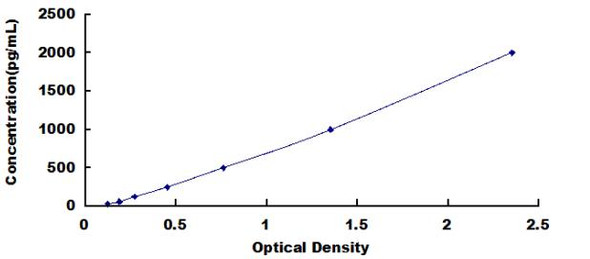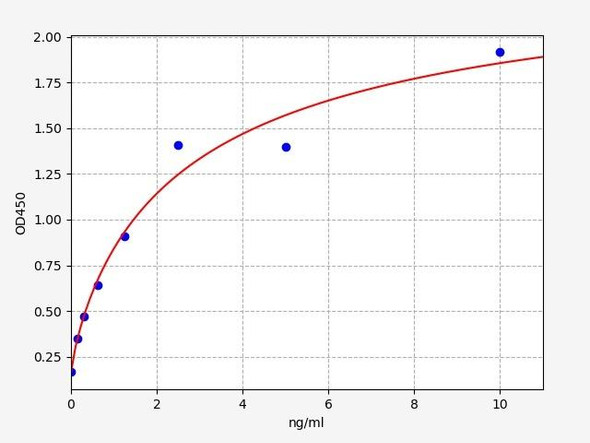Human Immunology ELISA Kits 1
Human DAF (Decay Accelerating Factor) CLIA Kit (HUES01068)
- SKU:
- HUES01068
- Product Type:
- ELISA Kit
- ELISA Type:
- CLIA Kit
- Size:
- 96 Assays
- Sensitivity:
- 7.5pg/mL
- Range:
- 12.5-800pg/mL
- ELISA Type:
- Sandwich
- Reactivity:
- Human
- Sample Type:
- Serum, plasma and other biological fluids
- Research Area:
- Immunology
Description
| Assay type: | Sandwich |
| Format: | 96T |
| Assay time: | 4.5h |
| Reactivity: | Human |
| Detection method: | Chemiluminescence |
| Detection range: | 12.50-800 pg/mL |
| Sensitivity: | 7.50 pg/mL |
| Sample volume: | 100µL |
| Sample type: | Serum, plasma and other biological fluids |
| Repeatability: | CV < 15% |
| Specificity: | This kit recognizes Human DAF in samples. No significant cross-reactivity or interference between Human DAF and analogues was observed. |
This kit uses Sandwich-CLIA as the method. The micro CLIA plate provided in this kit has been pre-coated with an antibody specific to Human DAF. Standards or samples are added to the appropriate micro CLIA plate wells and combined with the specific antibody. Then a biotinylated detection antibody specific for Human DAF and Avidin-Horseradish Peroxidase (HRP) conjugate are added to each micro plate well successively and incubated. Free components are washed away. The substrate solution is added to each well. Only those wells that contain Human DAF, biotinylated detection antibody and Avidin-HRP conjugate will appear fluorescence. The Relative light unit (RLU) value is measured spectrophotometrically by the Chemiluminescence immunoassay analyzer. The RLU value is positively associated with the concentration of Human DAF. The concentration of Human DAF in the samples can be calculated by comparing the RLU of the samples to the standard curve.
| UniProt Protein Function: | CD55: This protein recognizes C4b and C3b fragments that condense with cell-surface hydroxyl or amino groups when nascent C4b and C3b are locally generated during C4 and c3 activation. Interaction of daf with cell-associated C4b and C3b polypeptides interferes with their ability to catalyze the conversion of C2 and factor B to enzymatically active C2a and Bb and thereby prevents the formation of C4b2a and C3bBb, the amplification convertases of the complement cascade. Belongs to the receptors of complement activation (RCA) family. 2 isoforms of the human protein are produced by alternative splicing. |
| UniProt Protein Details: | Protein type:Membrane protein, GPI anchor; Cell surface Chromosomal Location of Human Ortholog: 1q32 Cellular Component: cell surface; integral to plasma membrane; extracellular region; plasma membrane; lipid raft Molecular Function:viral receptor activity; protein binding; lipid binding Biological Process: respiratory burst; entry of virus into host cell; elevation of cytosolic calcium ion concentration; negative regulation of complement activation; regulation of complement activation; innate immune response; regulation of lipopolysaccharide-mediated signaling pathway; complement activation, classical pathway Disease: Blood Group, Cromer System |
| NCBI Summary: | This gene encodes a protein involved in the regulation of the complement cascade. The encoded glycoprotein is also known as the decay-accelerating factor (DAF); binding of DAF to complement proteins accelerates their decay, disrupting the cascade and preventing damage to host cells. Antigens present on the DAF glycoprotein constitute the Cromer blood group system (CROM). Two alternatively spliced transcripts encoding different proteins have been identified. The predominant transcript encodes a membrane-bound protein expressed on cells exposed to plasma component proteins but an alternatively spliced transcript produces a soluble protein present at much lower levels. Additional, alternatively spliced transcript variants have been described, but their biological validity has not been determined. [provided by RefSeq, Jul 2008] |
| UniProt Code: | P08174 |
| NCBI GenInfo Identifier: | 10835143 |
| NCBI Gene ID: | 1604 |
| NCBI Accession: | NP_000565. 1 |
| UniProt Secondary Accession: | P08174,P09679, P78361, B1AP14, D3DT83, D3DT84, |
| UniProt Related Accession: | P08174 |
| Molecular Weight: | 41,400 Da |
| NCBI Full Name: | complement decay-accelerating factor isoform 1 preproprotein |
| NCBI Synonym Full Names: | CD55 molecule, decay accelerating factor for complement (Cromer blood group) |
| NCBI Official Symbol: | CD55 |
| NCBI Official Synonym Symbols: | CR; TC; DAF; CROM |
| NCBI Protein Information: | complement decay-accelerating factor; CD55 antigen |
| UniProt Protein Name: | Complement decay-accelerating factor |
| Protein Family: | Complement decay-accelerating factor |
| UniProt Gene Name: | CD55 |
| UniProt Entry Name: | DAF_HUMAN |
As the RLU values of the standard curve may vary according to the conditions of the actual assay performance (e. g. operator, pipetting technique, washing technique or temperature effects), the operator should establish a standard curve for each test. Typical standard curve and data is provided below for reference only.
| Concentration (pg/mL) | RLU | Average | Corrected |
| 800 | 52603 52681 | 52642 | 52616 |
| 400 | 20107 23361 | 21734 | 21708 |
| 200 | 9753 9663 | 9708 | 9682 |
| 100 | 4204 4900 | 4552 | 4526 |
| 50 | 2214 2162 | 2188 | 2162 |
| 25 | 1134 986 | 1060 | 1034 |
| 12.50 | 496 522 | 509 | 483 |
| 0 | 25 27 | 26 | -- |
Precision
Intra-assay Precision (Precision within an assay): 3 samples with low, mid range and high level Human DAF were tested 20 times on one plate, respectively.
Inter-assay Precision (Precision between assays): 3 samples with low, mid range and high level Human DAF were tested on 3 different plates, 20 replicates in each plate.
| Intra-assay Precision | Inter-assay Precision | |||||
| Sample | 1 | 2 | 3 | 1 | 2 | 3 |
| n | 20 | 20 | 20 | 20 | 20 | 20 |
| Mean (pg/mL) | 38.61 | 81.96 | 341.71 | 38.51 | 84.34 | 329.84 |
| Standard deviation | 3.26 | 8.16 | 38.13 | 4.19 | 8.53 | 30.18 |
| C V (%) | 8.44 | 9.96 | 11.16 | 10.88 | 10.11 | 9.15 |
Recovery
The recovery of Human DAF spiked at three different levels in samples throughout the range of the assay was evaluated in various matrices.
| Sample Type | Range (%) | Average Recovery (%) |
| Serum (n=5) | 88-101 | 93 |
| EDTA plasma (n=5) | 98-116 | 106 |
| Cell culture media (n=5) | 99-112 | 106 |
Linearity
Samples were spiked with high concentrations of Human DAF and diluted with Reference Standard & Sample Diluent to produce samples with values within the range of the assay.
| Serum (n=5) | EDTA plasma (n=5) | Cell culture media (n=5) | ||
| 1:2 | Range (%) | 96-111 | 97-111 | 85-96 |
| Average (%) | 103 | 103 | 91 | |
| 1:4 | Range (%) | 95-110 | 87-102 | 96-110 |
| Average (%) | 101 | 93 | 104 | |
| 1:8 | Range (%) | 94-106 | 96-107 | 94-109 |
| Average (%) | 99 | 101 | 100 | |
| 1:16 | Range (%) | 102-117 | 93-106 | 92-107 |
| Average (%) | 108 | 101 | 99 |
An unopened kit can be stored at 4°C for 1 month. If the kit is not used within 1 month, store the items separately according to the following conditions once the kit is received.
| Item | Specifications | Storage |
| Micro CLIA Plate(Dismountable) | 8 wells ×12 strips | -20°C, 6 months |
| Reference Standard | 2 vials | |
| Concentrated Biotinylated Detection Ab (100×) | 1 vial, 120 µL | |
| Concentrated HRP Conjugate (100×) | 1 vial, 120 µL | -20°C(shading light), 6 months |
| Reference Standard & Sample Diluent | 1 vial, 20 mL | 4°C, 6 months |
| Biotinylated Detection Ab Diluent | 1 vial, 14 mL | |
| HRP Conjugate Diluent | 1 vial, 14 mL | |
| Concentrated Wash Buffer (25×) | 1 vial, 30 mL | |
| Substrate Reagent A | 1 vial, 5 mL | 4°C (shading light) |
| Substrate Reagent B | 1 vial, 5 mL | 4°C (shading light) |
| Plate Sealer | 5 pieces | |
| Product Description | 1 copy | |
| Certificate of Analysis | 1 copy |
- Set standard, test sample and control (zero) wells on the pre-coated plate and record theirpositions. It is recommended to measure each standard and sample in duplicate. Note: addall solutions to the bottom of the plate wells while avoiding contact with the well walls. Ensuresolutions do not foam when adding to the wells.
- Aliquot 100 µL of standard solutions into the standard wells.
- Add 100 µL of Sample / Standard dilution buffer into the control (zero) well.
- Add 100 µL of properly diluted sample (serum, plasma, tissue homogenates and otherbiological fluids. ) into test sample wells.
- Cover the plate with the sealer provided in the kit and incubate for 90 min at 37 °C.
- Aspirate the liquid from each well, do not wash. Immediately add 100 µL of BiotinylatedDetection Ab working solution to each well. Cover the plate with a plate seal and gently mix. Incubate for 1 hour at 37 °C.
- Aspirate or decant the solution from the plate and add 350 µL of wash buffer to each welland incubate for 1-2 minutes at room temperature. Aspirate the solution from each well andclap the plate on absorbent filter paper to dry. Repeat this process 3 times. Note: a microplatewasher can be used in this step and other wash steps.
- Add 100 µL of HRP Conjugate working solution to each well. Cover with a plate seal andincubate for 30 min at 37 °C.
- Aspirate or decant the solution from each well. Repeat the wash process for five times asconducted in step 7.
- Add 100 µL of Substrate mixture solution to each well. Cover with a new plate seal andincubate for no more than 5 min at 37 °C. Protect the plate from light.
- Determine the RLU value of each well immediately.






